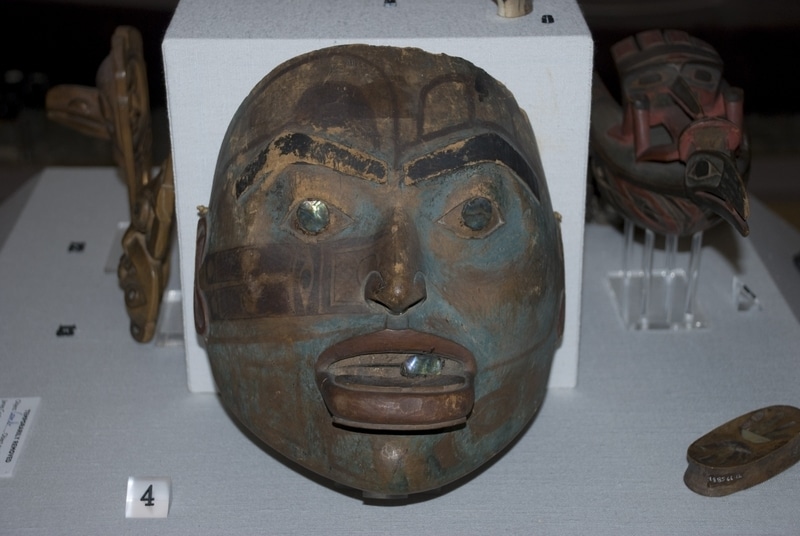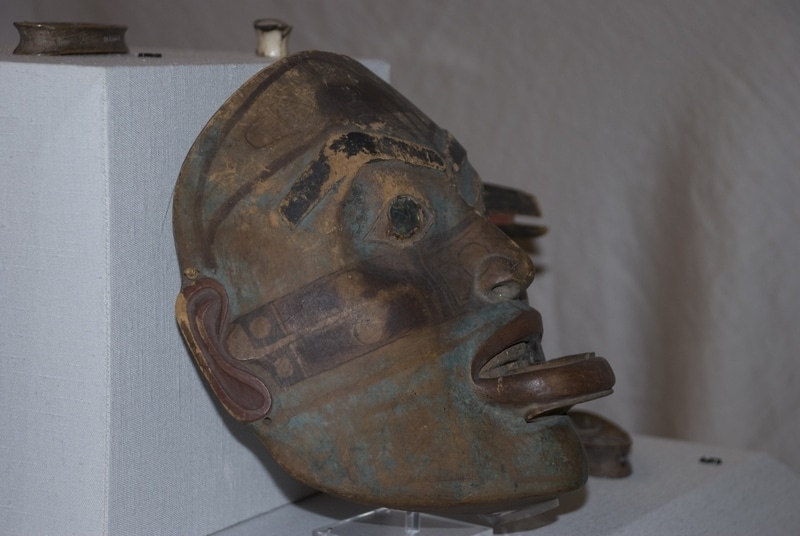Mask Item Number: E 1911.25 from the MAA: University of Cambridge



Description
A very fine mask of a woman carved in wood with inlaid haliotis shell eyes and teeth with a labret in the lower lip. The mask has prominent black eyebrows, a shapely nose with incised nostrils, the eyes are inlaid with discs of haliotis. The maskhas stylised ears which are painted red, and the open mouth has one remaining piece of haliotis, and the lips are also painted red. The mask has elaborate asymmetrical face-painting designs in black and pale blue. Part of the face-painting appears tobe fin-like and stretches across the nose and one cheek, having a cross-hatched portion and an eye. The upper edge of the mask is slightly damaged.; Good
Context
Although there is a clear provenance associated with these masks E 1911.25 26 the style of carving suggests a Tsimshian origin (G.Crowther). A note on the catalogue card states the mask may be numbered 1911.10 in the Blue Book. The original European tribal names and, where possible, current tribal names have both been given in separate GLT fields.; Tlingit shamans masks represented the spirits or Yek controlled by the shaman, and from whom he derived his power. Often they are associated with asymmetrical face-painting, and eyes which cannot be looked through while the mask is worn; the older masks are thought not to have eye-holes. This information, gleaned from Emmon' s work, The Tlingit Indians (Washington University Press: Seattle 1991) page 377-79, is not surprisingly in keeping with the information given by Finch who also consulted Emmons. However there is a fine line between identifying shamans masks and portrait masks which were worn at potlatches to commemorate a known ancestor. This point is also noted by Aldona Jonaitis in Art of the Northern Tlingit (Washington University Press: Seattle 1989) page 28. A difference has been suggested by Emmons, that the portrait masks had a cross-bar on the inside for the wearer to grip in their teeth, while the shamanic masks lack such a means of wearing. These two masks donot have mouth grips (G.Crowther).; Exhibited: Old Anthropological displays at CUMAA, case 21 and 22, number 20, dismantled 081986. New Anthropological displays at CUMAA, square case, object number 4, 1990 -.; Collected by: Finch.H.Wynne in 1900
Item History
- Made in Alaska, USA
- Received from H. Wynne Finch during 1911
What
- Name
- Mask
- Identification Number
- E 1911.25
- Type of Item
- mask
- Material
- wood, abalone shell and paint
Who
- Culture
- Tlingit: Auk ?
- Received from
- H. Wynne Finch
Where
- Holding Institution
- MAA: University of Cambridge
- Made in
- Alaska, USA
When
- Acquisition Date
- during 1911
Other
- Keyword
- Masques and Drama; Ceremonial Objects; Magic and Religion